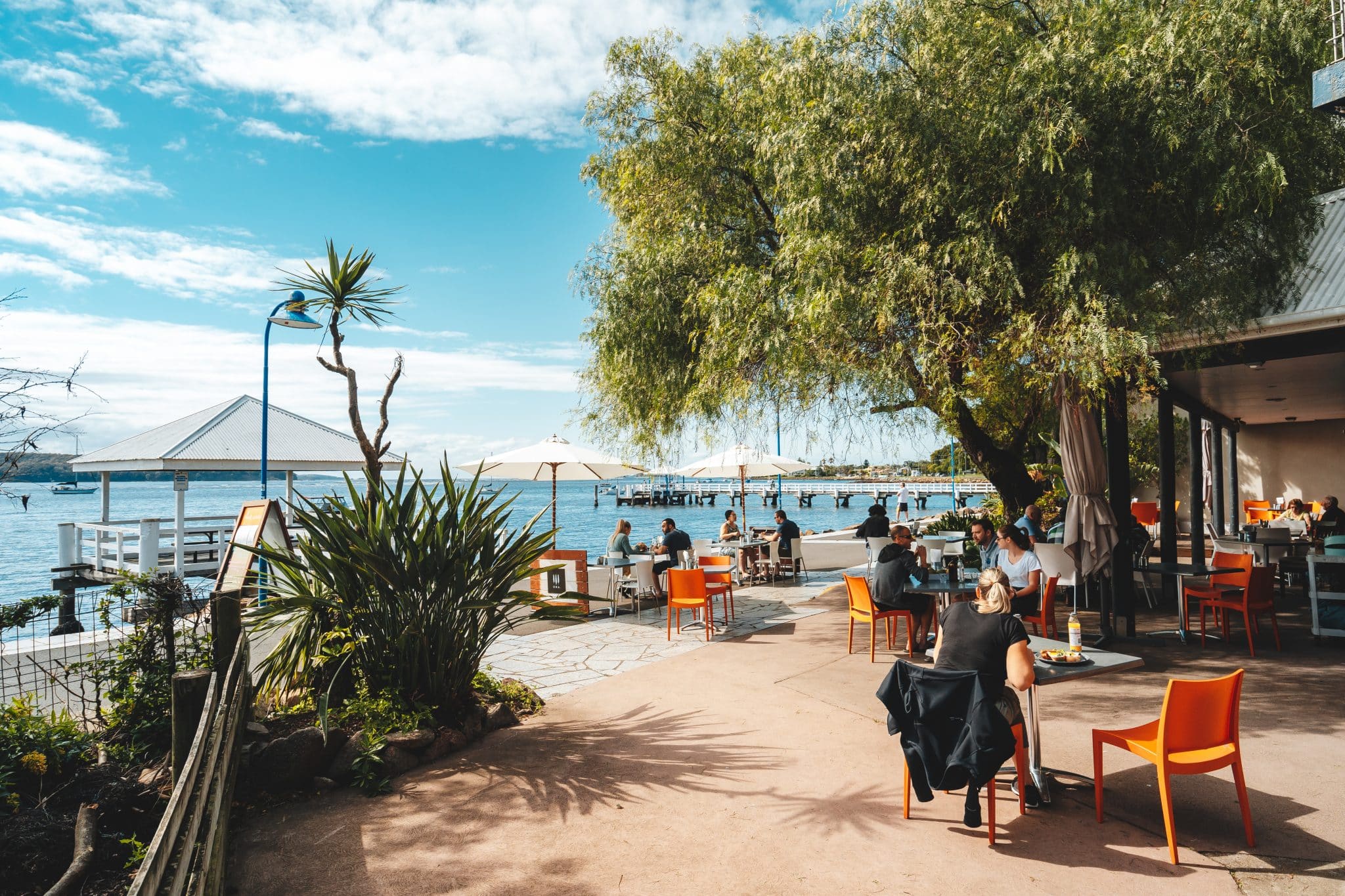BEST whale watching SPOTS
Each year, the waters off Eurobodalla’s coastline become a thoroughfare for migrating whales, providing excellent watching opportunities.
The largest living creatures in the world are just off the Eurobodalla coast!
Every year in late winter and spring, the waters of the Batemans Marine Park become a busy thoroughfare for humpback whales heading south from their northern breeding grounds to enjoy a summer of intense feeding in the Antarctic Ocean.
Whale watching season
Eurobodalla’s peak whale watching season runs from September to November. During their southern migration, whales are moving slowly and venture so close you can hear their breath as they exhale – scan the waters and you’re likely to be rewarded with a whale sighting.
Typical species that you would encounter on a whale watching tour include the southern right and humpback whales but you might also spot an orca.
Later in the season, female whales and their newborn calves can be spotted cruising, often just beyond the breakers. The pair of them travelling all that distance – one a giant of around 15m and possibly over 50 years old and the other a tiny 4m and just a few weeks old – is a symbol of hope and reassurance for the future.
During the height of whale watching season you can do whale watching from shore but for a truly exhilarating experience book a whale watching cruise.
Whale Watching Tours

Close encounters of the whale kind
From late winter through spring daily whale watching tours depart from Narooma, and depending on whale movements and numbers, also from Batemans Bay. Sea conditions, whale sightings and the stage of the annual migration will dictate how often whale watching cruises are available.
Your whale watching adventure will be led by an experienced skipper or guide. They will usually know where to find a pod of whales, often only minutes from the port. While there is never a whale guarantee, the odds of spotting whales and other marine life are very good mid season when whale numbers are high.
There are strict regulations that restrict approaching whales in boats but whale behaviour shows that often these curious ocean mammals will swim right up to stationery vessels for a bit of “people watching” and they don’t mind putting on a bit of a show. Make sure you have your camera ready to capture the amazing experience and the spectacular sight of whales breaching.
Conditions
Conditions apply to all charter tours. Weather conditions and minimum booking numbers may result in tours being postponed or cancelled, so book early in your stay.
Always check before you book if you need wheelchair access or have other accessibility requirements.
Departure times, sighting or free return trip guarantees are at the discretion of the operator. Enquire before making your booking.
View Whales from Land
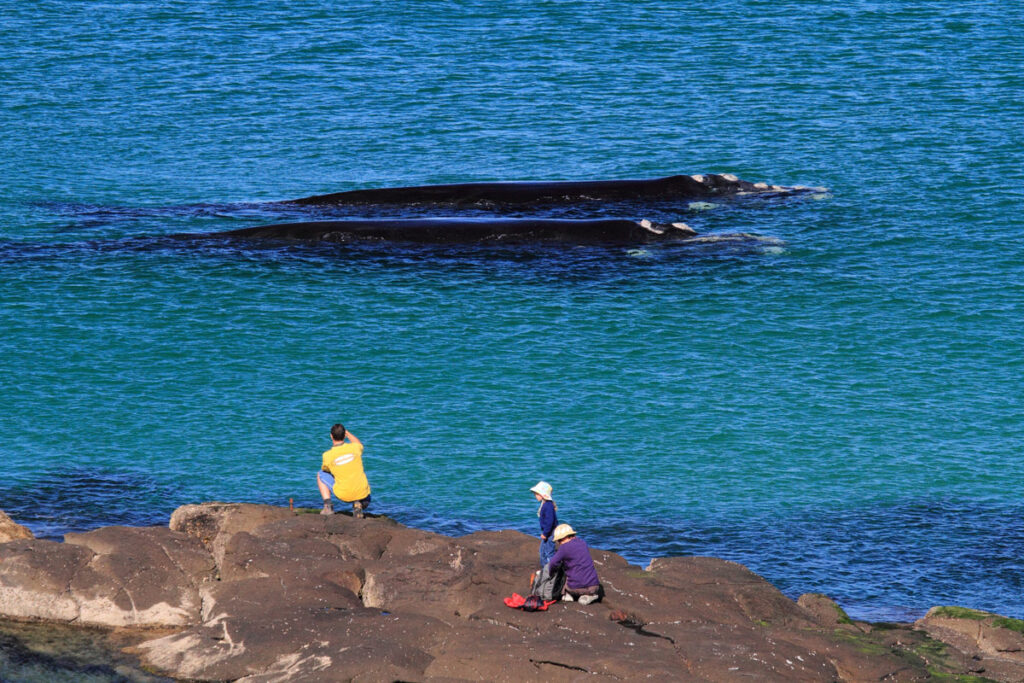
Look for the tell-tale spout or a splashing breach
Whale watching from land can be a rewarding experience. If you can’t get out on a whale watching tour you can still get to have a whale watching experience from shore.
Many whales come close to sure during the spring migration where you can observe whales behaviour. Humpback whales are commonly sighted but you may also see other whale species.
Suggested locations
Best land vantage points for whale watching around Narooma are Bar Rock lookout, Dalmeny headland and Carters beach headland at Kianga.
Further north, try whale watching at Broulee Island, Burrewarra Point at Guerilla Bay, Toragy Point at Moruya Heads, and South Head at Batemans Bay.
See a list of suggestions for whale watching from land.
Giant acrobats of the sea!
Of all the whales seen in the waters of Eurobodalla, it is ultimately the famous yet little understood acrobatics of the humpback whale that lure observers with the possibility that they may see a breach as they leap from the water and return with a mighty splash, or perhaps the awesome slapping of their giant fins and tail flukes on the water.
There’s also the dramatic tension that develops when whales dive. The minutes tick by and cameras are poised… eyes are scanning… suddenly there’s a massive roar of air as it exhales just metres from the boat or it explodes into the air in a spectacular spiraling breach.
Doubly rewarding!
Later in the season female whales nursing their calves may be cruising just beyond the breakers, so close you can sometimes hear their breath as they exhale. The pair of them travelling all that distance – one a giant of around 15m and possibly over 50 years old and the other a tiny 4m and just a few weeks old – is a symbol of hope and reassurance for the future.
Montague Island & whale watching brochure
A wildlife hotspot
Barunguba Montague Island is 9kms offshore from Narooma and is a hotspot for wildlife including some of the best whale watching on the east coast.
Humpbacks, southern right and orcas are regular visitors to these waters.
Learn more
Download the brochure and find out more about the whales around Barunguba Montague Island and the other amazing things to see and do on and around this stunning natural wonder
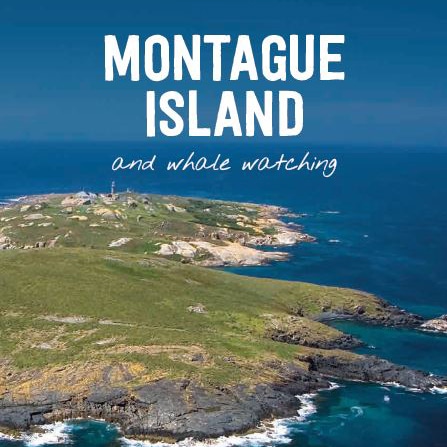
More about whales
Southern right whales, fin whales, Brydes whales, sei whales, sperm whales and blue whales have also all been seen off Narooma in recent years and there has even been a sighting of a rare albino humpback off Barunguba Montague Island, known as Migaloo.


Humpback whales
Megaptera novaeangliae
The East Coast Australia population
After years of excessive hunting along the migration route, whaling was banned in the 1960s. The population had dwindled to just over 100 individuals.
By 2009 the population had recovered to over 10,000 individuals with an annual estimated increase of 10-15%. In 2020 the population travelling along the East Coast of Australia was estimated to be more than 35,000 whales.
Humpback distinguishing features
The humpback whale can grow to 16m in length and develop very long pectoral fins. They are dark brown to black on the back with white on the belly, flanks and flippers. The dorsal fin is roughly two-thirds down along their back. The tail flukes have scalloped edges. Their unique pectoral (front) flippers can be up to 6m long, also with bumpy scalloped edges. They have a knobby head and distinctive throat grooves.
They have a wide bushy shaped blow up to 4m high when exhaling from their twin blowholes.
Southern hemisphere humpback whales may have a lot of grey or white on their bodies. “Migaloo” is a famous albino humpback you may be very lucky to see.
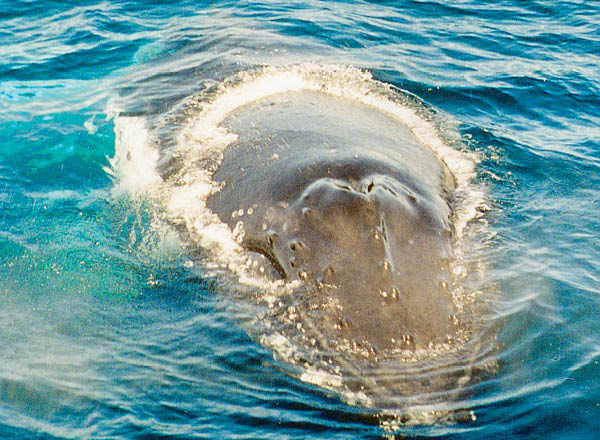
Humpback visible body parts
Rostrum
Flat area above the mouth, extends back to blowholes. Has bumps (tubercules) on the top.
Pectoral Fins
Forward fins, in proportion to a third of the length of the whale’s body.
Dorsal fin
A relatively small fin right on the back about two-thirds along the body. Many different sizes and shapes.
Caudal Peduncle
Sometimes called the tailstock. This is the immensely strong rear section of the body between the dorsal fin and the tail flukes.
Tail Flukes
The two sides of the tail are called flukes. Quite often they carry scars and have bits missing from past attacks and other injuries. These are distinctive and used by scientists to identify individual whales.
What about the hump?
They actually don’t have one. They get their name from the arch of their tailstock as they sound – the only whales to have such a pronounced u-bend.

Humpback behaviours
Cruising
Two to five breaths at the surface then dive for up to 10 – 15 minutes but usually less.
Sounding
The animal arches the tailstock into a u-bend as they dive. The distinctive humpback tail flukes are often held high for a moment. Usually indicates a deeper dive.
Lunging
Front of head (rostrum) comes out of water and dives back under. Sometimes the whole head may appear.
Peduncle Slap
Tail is raised and chopped back into the water with a sideways motion using the flexible Peduncle which is the strong muscular area just before the flukes.
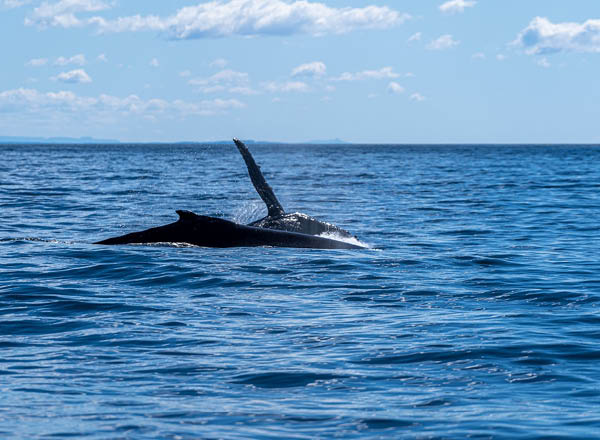
Tail Slapping
Whale is upside down underwater. Can smack the whole tail repeatedly on the water in either direction.
Tail Swish or Roll
A flicking movement where the tail is slammed sideways and down as the whale submerges.
Flipper Flapping or Pectoral Slapping
One or more pectoral fins are repeatedly raised and then flapped loudly back onto the surface. Sometimes extended above water for several minutes. Sometimes appears to be backstroking.
Spy-hopping
The whale hangs vertically sculling in the water and the nose and head may rise upwards, sometimes as far as the eye.
Feeding
You may see one half of a tail fluke and sometimes the belly scything through the water, with rapid changes of direction. Followed by a period underwater than a repeat of the process.
Humpback songs
There’s still so much to learn about the beautiful music of the Humpback whales. Sounds that have been recorded off Hawaii over the last few years – described as pulse sounds – have been found to have a frequency of around 40 Hz. This is a lower frequency than the songs of the male humpbacks, which have an audio frequency between 80 and 4,000 Hz and researchers are now considering whether this may be sounds of the female humpbacks, previously thought to have no song.
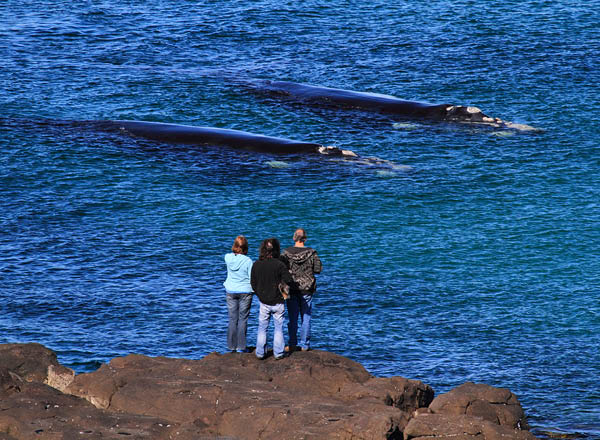
Southern right whales
Eubalaena australis
The East Coast Australia population
Right whales were one of the first to be targeted for hunting on a large scale.
They were considered the “right whale” to hunt because of their slow speed and thick blubber layers which make them very buoyant and easy to harvest once dead. Their huge size provided large quantities of valuable and desirable commodities – oil, meat and baleen.
They were pushed to the brink of extinction and hunting was officially banned in the 1930s, although illegal hunting continued for decades. Southern right whales are listed as a threatened species in NSW and WWF estimates a population of around 3,500 individuals in Australian waters.

Distinguishing features
Size
Between 15-17m with females slightly longer. Calf around 4-6m. Maximum weight is around 100 tonnes (100,000 kgs)
Appearance
A large round shape with massive girth and broad backs. Their large heads with a massive lower jaw, take up to a third of the entire body length. Creamy coloured lumps (callosites) cover the head and jaw which can be an identifying feature on individual whales. Their upper side is dark brown to black with patches of white on the belly. The dorsal fin is absent. They have two blow holes that produce a wide v-shaped blow pattern several metres high.
Flippers are short and paddle shaped with blunt edges and the tail is large with black flukes with smooth edges.
Behaviour
Southern right whales can be quite acrobatic.
Observed behaviours include head-stands with the head submerged and waving their flukes in the air and spyhopping.
Another commonly observed behaviour is the use of the tail flukes like a sail to push them along in the wind. Flipper slapping on the surface of the water and bellowing and moaning during the breeding season has also been observed.
Southern right whales live in groups of up to a dozen but are usually seen in groups of two or three.
Right whales eat plankton and krill, sieving the tiny prey through the baleen plates in their large mouths by cruising just below the water surface.
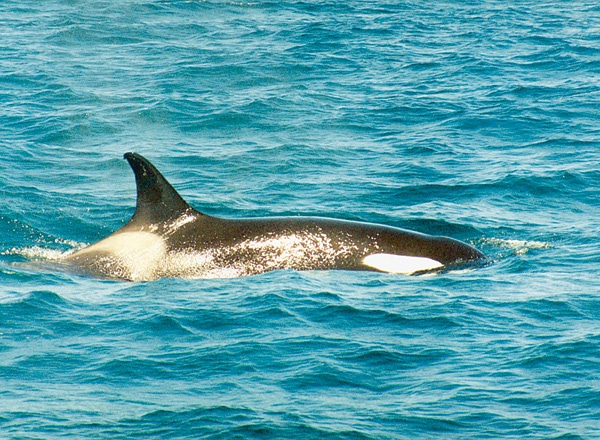
Killer whales
Ornicus orca
Whales stalking whales
Humpbacks not only bring many tourists to the region, but also the most feared predator of all the ocean, killer whales. Researchers from Killer Whales Australia believe the whales, which are actually not whales at all, but the largest members of the dolphin family, follow the humpback migration from Jervis Bay to Barunguba Montague Island. Barunguba Montague Island, only nine kilometres from Narooma, is an ‘island cafe’ for the killer whales, where they can feast on seals, resting humpback youngsters, sharks, kingfish and other marine life. Numbers of killer whales are low in the region and sightings are special.
In Eurobodalla, fishermen, tour guides and locals are all involved in reporting and collecting information about the mysterious and fascinating killer whales.
Killer Whales Australia has been studying the killer whales, which are actually a type of dolphin, in southern waters for decades and is being helped along the way by the Eurobodalla community.
Despite their charismatic profile, little is understood about killer whales in the coastal waters of Australia. The citizen’s science project aims to better understand these apex predators and achieve a conservation listing for the whales in Australia.
Killer whale habits
Did you know these busy hunters are fussy eaters? They like shark livers, but not whale blubber, preferring their lips and tongues. Like the smaller dolphins they also like to bow ride and have been known to come up to boats.
For more information about the Citizen’s Science Project and how to call in a sighting go to their Facebook page.

